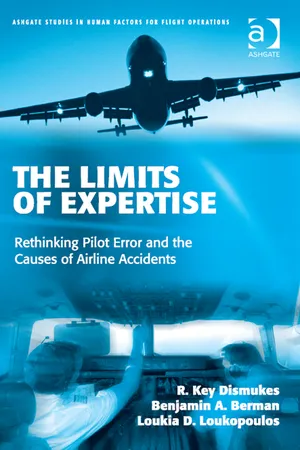
- 364 pages
- English
- PDF
- Available on iOS & Android
The Limits of Expertise
About This Book
Why would highly skilled, well-trained pilots make errors that lead to accidents when they had safely completed many thousands of previous flights? The majority of all aviation accidents are attributed primarily to human error, but this is often misinterpreted as evidence of lack of skill, vigilance, or conscientiousness of the pilots. The Limits of Expertise is a fresh look at the causes of pilot error and aviation accidents, arguing that accidents can be understood only in the context of how the overall aviation system operates. The authors analyzed in great depth the 19 major U.S. airline accidents from 1991-2000 in which the National Transportation Safety Board (NTSB) found crew error to be a causal factor. Each accident is reviewed in a separate chapter that examines events and crew actions and explores the cognitive processes in play at each step. The approach is guided by extensive evidence from cognitive psychology that human skill and error are opposite sides of the same coin. The book examines the ways in which competing task demands, ambiguity and organizational pressures interact with cognitive processes to make all experts vulnerable to characteristic forms of error. The final chapter identifies themes cutting across the accidents, discusses the role of chance, criticizes simplistic concepts of causality of accidents, and suggests ways to reduce vulnerability to these catastrophes. The authors' complementary experience allowed a unique approach to the study: accident investigation with the NTSB, cognitive psychology research both in the lab and in the field, enormous first-hand experience of piloting, and application of aviation psychology in both civil and military operations. This combination allowed the authors to examine and explain the domain-specific aspects of aviation operations and to extend advances in basic research in cognition to complex issues of human performance in the real world. Although The Limits of Expertise is directed to aviation operations, the implications are clear for understanding the decision processes, skilled performance and errors of professionals in many domains, including medicine.
Frequently asked questions
Information
Table of contents
- Cover
- Half Title
- Title Page
- Copyright Page
- Table of Contents
- List of Figures
- List of Tables
- Foreword
- Preface
- Acknowledgments
- Dedication
- Introduction
- 1 USAir 1016 – Windshear Encounter
- 2 TWA 843 – The Power of Suggestion
- 3 American 1572 – Accumulation of Small Errors
- 4 American International 808 – The Strobe Light that Wasn’t There
- 5 Southwest 1455 – Unstabilized Approach at Burbank
- 6 FedEx 14 – Pilot-Induced Oscillations in the Landing Flare
- 7 Ryan 590 – A Minute Amount of Contamination
- 8 Tower 41 – Loss of Control During a Slippery Runway Takeoff
- 9 Continental 1943 – Gear-Up Landing in Houston
- 10 American 102 – Runway Excursion After Landing
- 11 Continental 795 – High-Speed Takeoff Decision with Poor Information
- 12 USAir 405 – Snowy Night at LaGuardia
- 13 ValuJet 558 – Two Missing Words and a Hard Landing Short of the Runway
- 14 Air Transport International 805 – Disorientation, Loss of Control and the Need to Intervene
- 15 American 903 – Loss of Control at Altitude
- 16 Simmons 3641 – Over the Gates and into Forbidden Territory
- 17 American 1340 – Autopilot Deviation Just Prior to Landing
- 18 Delta 554 – Undershot Landing at LaGuardia
- 19 American 1420 – Pressing the Approach
- 20 Flightcrew-Related Accident Data: Comparison of the 1978–1990 and 1991–2001 Periods
- 21 Converging Themes: The Deep Structure of Accidents
- Glossary
- Bibliography
- Index